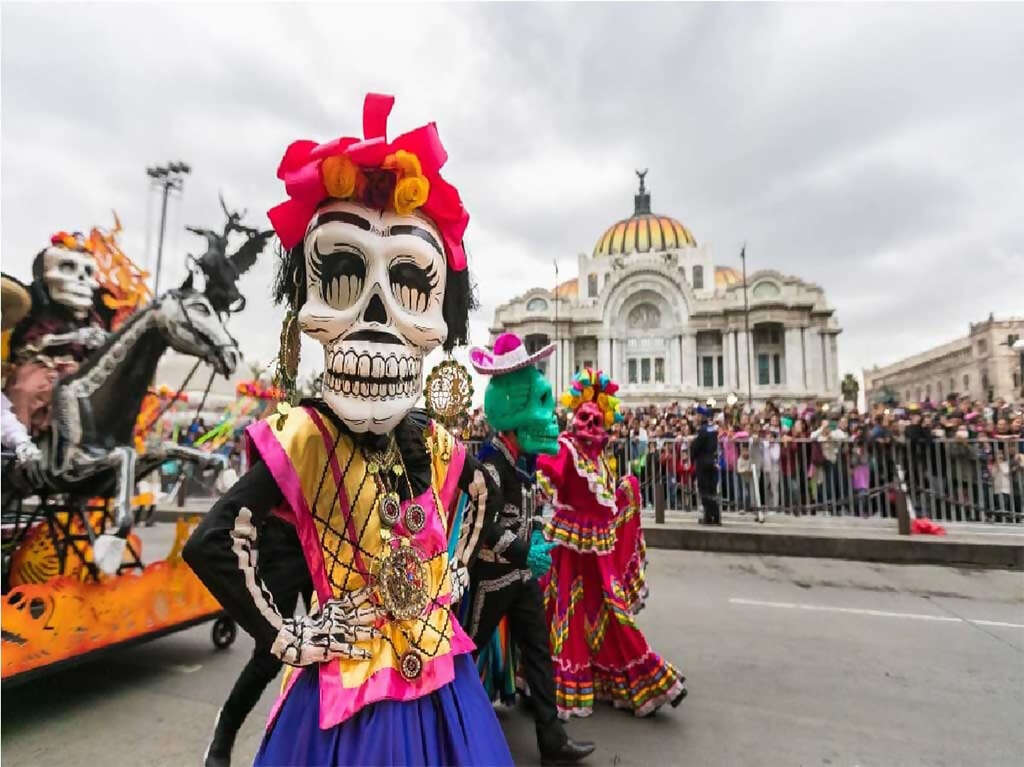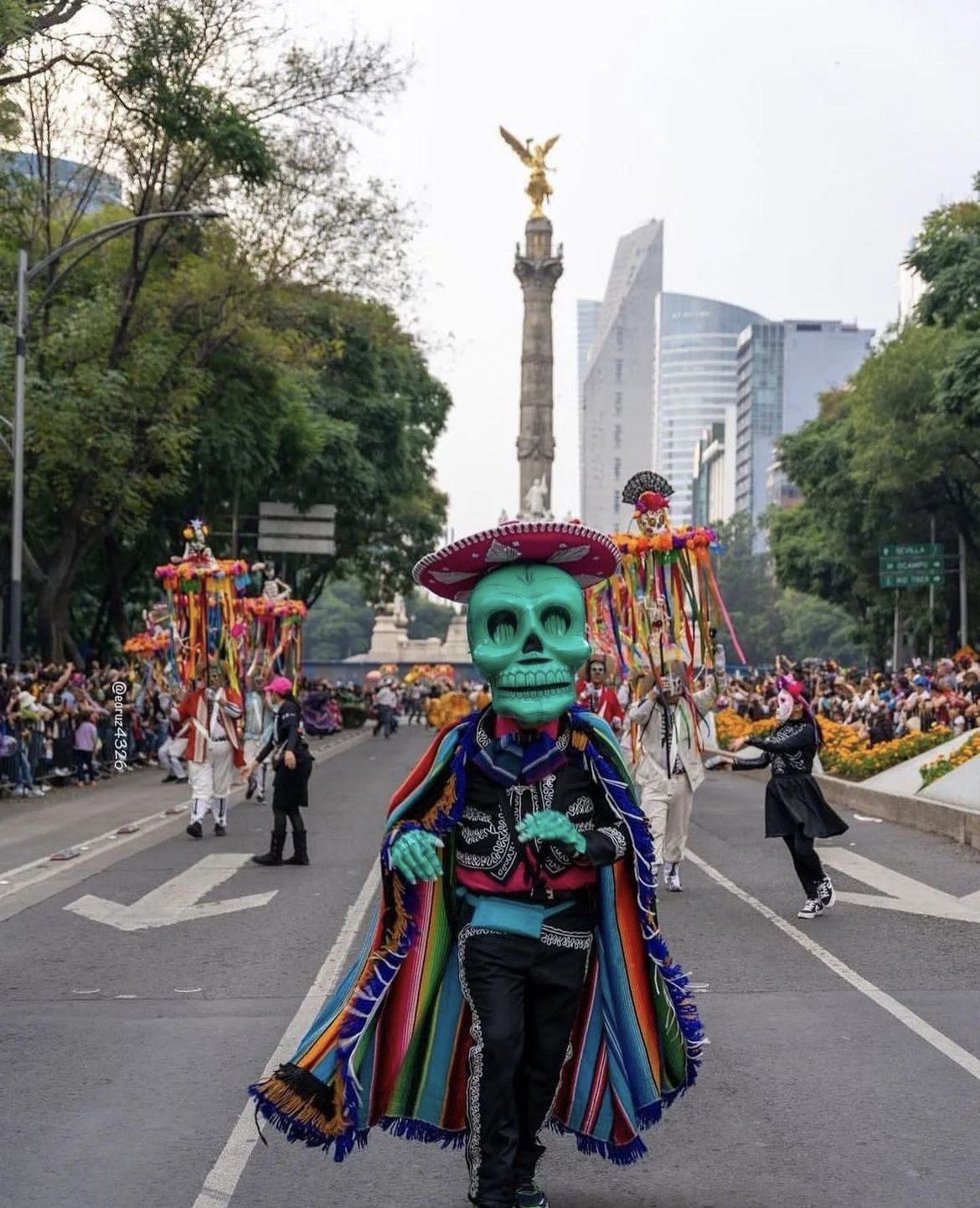
On November 2, Mexico City will transform into a river of color, culture, and remembrance as the Day of the Dead Grand Parade returns for 2025, featuring giant skeleton puppets, floats, music, dancers, and costumes. This extraordinary four-hour procession honors ancestors who have passed while celebrating the joy of life. At the same time, it offers travelers from around the globe an unforgettable immersion into one of Mexico’s most cherished cultural traditions.
It’s a case of life imitating art! Or even art creating new reality! That’s because Mexico City’s larger-than-life Day of the Dead Grande Parade is not – unlike other Day of the Dead traditions – a centuries-old practice.
In fact, it didn’t exist at all until 2016. That’s the year after the James Bond film Spectre famously opened with a spectacular Day of the Dead parade scene located in Mexico City. It was entirely a figment of the filmmakers’ imaginations! But the scene in the film created such a vivid impression of the capital, and so many film-goers around the world assumed it was real, that Mexico City’s government decided to establish an official Dia de los Muertos parade; and so a new tradition was born, putting Mexico’s cultural heritage on the world stage.
The parade incorporates traditional Day of the Dead imagery, including La Catrina, (the elegantly-garbed female skeleton), marigolds (the flower of the dead) and skulls, but presents it in a modern, theatrical format that appeals to the large crowds that now throng to Mexico City for this new cultural spectacle, usually held on the last weekend before Day of the Dead.

Traditional Day of the Dead in Mexico
Recognized by UNESCO as part of the Intangible Cultural Heritage of Humanity, Day of the Dead (Día de los Muertos) is a holiday rooted in and blending pre-Hispanic, ancient indigenous rituals and Catholic traditions. Celebrated on November 1 and 2, it honors the souls of children and adults who have passed away.
Through altars, offerings, flowers, food, and gatherings, families welcome spirits back for a brief reunion. It is at once deeply spiritual and joyously festive, reflecting Mexico’s unique approach to life and death.
A Living Tradition
Mexico City’s relatively newborn Grand Parade begins at the Puerta de los Leones in Chapultepec Park, winds its way down the iconic Paseo de la Reforma, passes Avenida Juárez and 5 de Mayo, and concludes in the heart of the capital at the Zócalo, Mexico City’s grand central square.
It complements, rather than replaces, the more intimate commemorations in small communities across the country.

Beyond Mexico City: Celebrations Across the Country
These celebrations are deeply rooted in local traditions — with each region adding its own distinct flavors and rituals.
- Oaxaca: Perhaps the most famous destination outside the capital, Oaxaca comes alive with processions in its cobblestone streets. Locals dress as skeletons, brass bands play through the night, and markets overflow with pan de muerto and sugar skulls. Cemeteries become places of gathering as families decorate graves with candles, flowers, and offerings.
- Pátzcuaro, Michoacán: Families light thousands of candles in this lakeside community to guide spirits back to the world of the living, while the island of Janitzio becomes a glowing beacon seen across the lake. This atmospheric celebration is deeply tied to Indigenous tradition and is one of the most poignant experiences in Mexico.
- San Andrés Mixquic, Mexico State: Just outside Mexico City, this small town is renowned for its “Alumbrada” on November 2. As night falls, cemeteries blaze with candlelight, transforming the grounds into a shimmering tribute to departed souls. Families maintain vigil, often sharing food, music, and stories late into the night.
- Mérida, Yucatán: Here, the holiday takes the form of Hanal Pixán, or “food for the souls.” Rooted in Maya tradition, this celebration features altars laden with regional specialties like mucbipollo, a large tamale baked underground. The streets of Mérida host processions, while families gather in cemeteries to honor their ancestors.
Each of these destinations shares the same essence: honoring the departed through joy, remembrance, and community. For travelers, experiencing Day of the Dead traditions anywhere in Mexico at the beginning of November is a way to see the country’s cultural richness up close.
START YOUR TRIP!
Images courtesy of Visit Mexico
All rights reserved. You are welcome to share this material from this page, but it may not be copied, re-published, broadcast, rewritten or redistributed.
Start your trip to
Let us help you plan your trip
Where do you want to go?
Featured Experiences
Save up to 40% on Explora Journeys – for a Limited Time Only!
Only until December 1, save up to 40% across Explora Jou... more
Black Friday Cruise Savings! Up to 35% Off and More on Scenic and Emerald River and Yacht Cruises
Discover the world’s most extraordinary destinations with... more
Black Friday Sale: Up to 40% Off Select Voyages and More Savings on Cunard
Only until December 8, 2025, plan your next luxury voyage... more
Princess Cruises’ “Blue Friday” Deal: up to 50% Off – and Free 3rd and 4th Guests!
Move over Black Friday! Princess Cruises is sailing into ... more
Get Up to 20% Off Intrepid Adventure Trips for Black Friday!
Intrepid Travel is giving you big savings this Black Frid... more
Royal Caribbean Expands Alaska Cruisetours in 2027
Royal Caribbean has revealed its lineup of summer 2027 ge... more
Popular Posts
- 8 Facts About the Panama Canal
- 10 Amazing Facts about the Tasmanian Devil
- Top 6 Wellness and Fitness Cruises You Should be Booking Now
- Where's the Only Restaurant in Alaska by a Michelin Starred Chef?
- Top 10 Reasons to Travel to Croatia
- Discover Tropical Romance in 3 Overwater Bungalow Resorts on the Caribbean Sea





